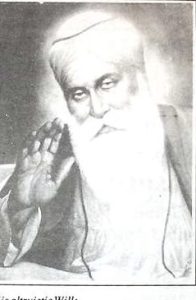
Guru Nanak created a religious revolution in India. The credentials of his religion are entirely different from the essentials of other Indian religions. This is s0, because the Guru’s perception is that God is the Ocean of Virtues, He is interested in the world, and expresses His virtues therein. This perception leads to his Miri-Piri doctrine of combining the religious life with empirical life. Accordingly, he changed the fundamentals of his religion from those of dichotomous Indian religions.
Consequently, (1) against the world being Mithya or suffering he called it real; (2) against life negation he recommended life affirmation; (3) against asceticism, monasticism and sanyas, he chose house holder’ s life; (4) against woman being a temptress he called her mother of life; (5) against Varanashram dharma, caste and pollution, he established equality of man and common Sangat (society) and Pang at (inter-dining); (6) against sanyas, begging and other wordiness, he recommended work and sharing of one’s earnings and natural wealth (7) against the goal of merger in God, He recommended carrying out of His altruistic Will: (8) against the methodology of sanyas, meditation or Yoga alone he recommended essentiality of deeds; (9) he rejected Ahimsa and the invincibility of its religious character; against lack of social participation he recommended participation and complete social political responsibility for reaction against injustice and oppression, because he called his God Destroyer of evildoers’ (11) against Jivan -mukta being unconcerned with social political life, he organized Sikh society, and created the institution of succession to resist in justice in all fields. Accordingly, He not only called truthful conduct greater than truth, but also gave a call to all seekers to join his Society for living a life of love.
The society he organized had ideals of (a) equality between man and woman (b) equality between man and man (c) of sustaining the social structure with work, production and sharing, and (d) confronting oppression and injustice in all fields.
In order to develop this new society, he started the institution of succession to enable his successors to create necessary institutions and scripture and to mature it. Guru Gobind Singh did the epitomic work of creating Khalsa with Naash doctrine of complete break with earlier religious systems and institutions.
The Sikh society achieved the target of equality among men and women, of work habit and egalitarianism and of breaking political oppression. In token of maturity of Sikh society Guru Gobind Singh himself had Amrit from the Five Pairs. A hundred years before the French Revolution, Sikh society achieved the ideal of Fraternity, Liberty and Equality, with its leaders from the lowest classes something which even the French revolution never achieved.
Article extracted from this publication >> November 22, 1991